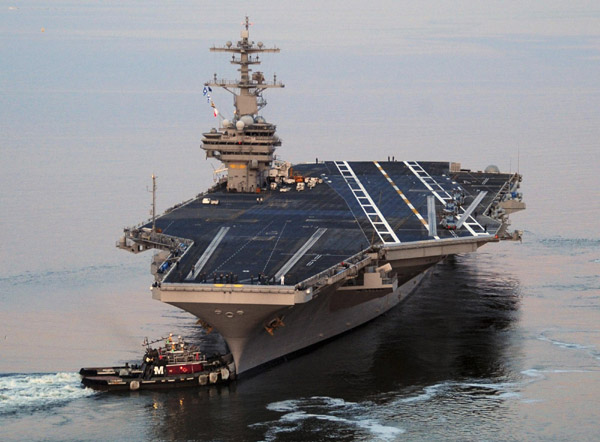Photos
Snapshots of US aircraft carriers
Updated: 2011-05-13 11:27
(Agencies)
ABOARD THE CHARLES DE GAULLE - Despite growing controversy about the cost and relevance of aircraft carriers, navies around the world are adding new ones to their inventories at a pace unseen since World War II.
The US _ with more carriers than all other nations combined _ and established naval powers such as Britain, France and Russia are doing it. So are Brazil, India and Russia from the BRIC grouping of emerging economic giants.
"The whole idea is about being able to project power," said Rear Adm. Philippe Coindreau, commander of the French navy task force that has led the air strikes on Libya since March 22.
"An aircraft carrier is perfectly suited to these kinds of conflicts, and this ship demonstrates it every day," he said in an interview aboard the French carrier Charles de Gaulle, which has been launching daily raids against Moammar Gadhafi's forces since the international intervention in the Libyan conflict began March 22.
The 42,000-ton nuclear-powered carrier has been joined in this task by another smaller ship, Italy's 14,000-ton Giuseppe Garibaldi. None of the US Navy's supercarriers have been involved, despite American participation in the war's initial phase.
The floating fortresses became the backbone of US sea power after WWII, projecting military might around the world in crises and in conflicts such as Korea, Vietnam, Iraq, Kosovo and Afghanistan.
Lee Willett, head of the maritime studies program at the Royal United Services Institute, a London-based military think tank, said the war in Libya illustrated the usefulness of carriers to other navies with more regional interests.
France and Italy, the NATO nations closest to the North African coast, chose to deploy their ships on operations although they have air force bases within easy reach, he noted.
"All around the world there are major and not-so-major navies now looking into getting into some form of sea-based airpower," Willett said. "They may not want to be global powers but they certainly want to have some regional power-projection capability."
The exact number of aircraft carriers in service worldwide is difficult to establish because of the proliferation of vessels that are classified as amphibious warfare ships, helicopter carriers or even cruisers or destroyers _ but that fit the classic definition of a carrier as a mobile air base with a flat deck from which aircraft take off and land.
These include the United States' eight 41,000-ton Wasp-class amphibious warfare ships, whose standard complement includes Harrier jets and SuperCobra helicopter gunships, in addition to transport choppers.
The French Mistral Class, Britain's HMS Ocean, and Spain's Juan Carlos I share the same concept of multipurpose ships that can carry strike jets, helicopters and hundreds of marines for amphibious landing operations.
Even Japan's two Hyuga class "destroyers" have the characteristic flat deck, effectively making them carriers despite their official designation.
"At the end of the day, the popularity of carriers is due to the fact that these are very flexible platforms that can be used for a wide variety of tasks and not just warfare," said Nate Hughes, director of military analysis at the U.S.-based think tank Stratfor.
The US Navy is scheduled to induct the Gerald R. Ford, the lead ship of a new class three-ship class of supercarriers, in 2015. Each is expected to cost about $9 billion.
Other NATO nations adding flattops to their fleets include Britain, already building two ships, and France, which is considering procuring a second nuclear-powered vessel. Spain and Italy have just inducted two new flattops.
India is building its first homegrown flattop. Russia will modernize its Admiral Kuznetsov carrier next year to extend its life until after 2030, and plans to acquire French Mistral-class ships.
Brazil has completed an extensive refit of the recently acquired French carrier Foch _ now renamed the Sao Paolo _ which has become its navy's flagship.
"The BRIC navies in particular are all getting into ... major aircraft carriers," said Willett.
Military experts have long debated the relevance of aircraft carriers, which some have dismissed as relics of the Cold War.
"What many countries don't realize is that sustaining operations at sea is a very complex task," Hughes said. "The magnitude of the expense necessary to get to that sort of fixed wing capability that the US and French navy have is difficult to overstate."
Some critics say the entire concept of the seagoing air base is now antiquated. They contend that advances in anti-ship weapons have turned the carriers into white elephants that are just too expensive to risk losing in a war.
While the mammoth floating airports bristling with jets and missiles appear invincible, the reality is that since World War II they have mostly been used in conflicts with far weaker opponents. They have yet to face off against modern navies with their array of carrier-killing ballistic missiles, super-torpedos, and supersonic cruise missiles.
"These new technologies make it easier to target carriers from much greater distances," said Benjamin Friedman, a research fellow with the Washington-based CATO Institute.
"Those technologies are set to advance faster than the ability to defend against them, meaning that in a couple of decades the carrier business may not be viable anymore."
E-paper

Green works
Wuxi becomes 'test case' for facing country's environmental challenges
The global rise of Chinese brands
China-EU trade on solid ground
ZTE banks on innovation
Specials

The song dynasty
There are MORE THAN 300 types of Chinese operas but two POPULAR varieties are major standouts

Cut above the rest
One of the world's oldest surgeons has performed more than 14,000 operations

From the ground up
Architect of Guangzhou Opera House has many projects under way, including 2012 Olympics.

